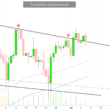Investor sentiment across the globe has remained largely bearish in early July, according to the Bank of America (BofA) Global Fund Manager Survey. Despite growing optimism surrounding the possibility of a “soft” economic landing and avoiding a recession, sentiment has not significantly improved. The stock market, however, has seen a boost due to the increasing rush towards megacap technology stocks.
The BofA’s fund manager sentiment, which is based on factors such as cash positions, equity allocation, and economic growth expectations, continues to stay “stubbornly low” and shows no signs of improvement in the second half of 2023. Michael Hartnett, leading a team of investment strategists, emphasizes that the majority of surveyed fund managers anticipate weaker global economic growth.
Interestingly, 48% of the fund managers surveyed predict that a global recession will begin by the end of the first quarter of 2024. However, there has been an increase in bets on a soft landing scenario, with 68% of respondents favoring this view. This figure surpasses the 21% who anticipate a “hard landing” and the mere 4% who forecast a “no landing” scenario.
Overall, investor sentiment remains cautious, with concerns over global economic growth persisting. While hopes for a soft landing offer some relief, the majority of fund managers are preparing for a potentially rockier road ahead.
The Central Banks’ Battle Against Inflation
In the ongoing struggle against post-pandemic inflation, central banks worldwide are striving for a soft landing. This analogy compares the process to that of a pilot skillfully guiding an aircraft for a smooth landing. The objective is to slow down the economy just enough to manage inflation while avoiding a recession. However, a hard landing occurs when central banks reign in the economy excessively to control inflation, resulting in a recession. On the other hand, a “no landing” scenario emerges when the economy continues to grow despite policymakers’ efforts to suppress inflation by increasing interest rates.
Economic Indicators and Risk Sentiment
Additionally, several indicators shed light on risk sentiment. The expectations for earnings-per-share (EPS) show a notable shift towards positivity. Currently, EPS forecasts have reached their least pessimistic level since February 2022. According to BofA strategists’ analysis, the global EPS forecast for the next 12 months has experienced a slight 0.5% increase.
The Rise of Big Tech and Artificial Intelligence
The majority of investors are now heavily invested in “Big Tech.” A recent survey conducted by BofA revealed that 42% of polled investors anticipate increased corporate profits over the next two years due to the widespread adoption of artificial intelligence (AI). In contrast, only 1% believe that AI will create more job opportunities.
Federal Reserve’s Interest Rate Cuts
Fund managers predict that the Federal Reserve will lower U.S. interest rates during the second quarter of 2024. According to Fed funds futures traders, there is a 36% probability that the Fed’s main policy rate target will fall to between 5% and 5.25%, or even lower, by January 2024. These insights are gleaned from the CME FedWatch Tool.
U.S. Stocks Show Positive Momentum on Strong Corporate Earnings
The U.S. stock market witnessed a surge in trading on Tuesday afternoon, following the release of impressive corporate earnings reports. Investors rejoiced as the Dow Jones Industrial Average (DJIA) experienced a notable increase of 345 points, equivalent to a 1% rise, bringing it to a value of 34,931. Moreover, the S&P 500 (SPX) exhibited a 0.5% hike, while the Nasdaq Composite (COMP) saw a gain of 0.7%.





